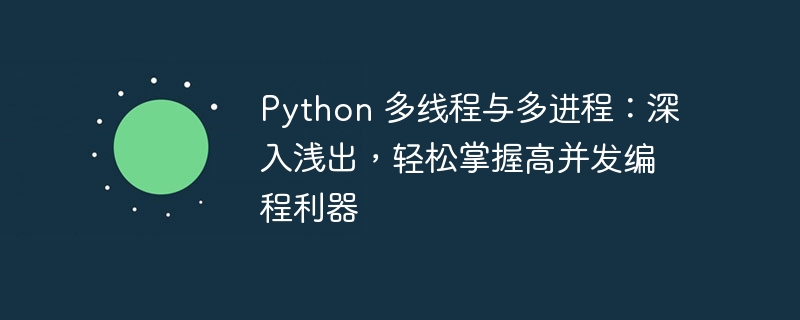

pythonMulti-threading and multi-process are two different parallel programming technologies, both of which can be used for writing efficient and scalable applications. MultiThreading refers to creating multiple threads in one process, while multi-process refers to creating multiple processes.
Multi-threading is achieved by creating multiple threads in a single process. Concurrent programming. Each thread is an independent execution stream and they share the same memory space. This means that threads can easily access and modify each other's data. However, multithreading also has some disadvantages. First, multithreading can lead to race conditions, which are data inconsistencies when multiple threads access shared data at the same time. Secondly, multi-threading may also lead to dead locks, which is a stalemate caused by multiple threads waiting for each other to release resources. multi-Progress
programming by creating multiple processes. Each process is an independent memory space, and they communicate with each other through the inter-process communication (IPC) mechanism. The advantage of multiple processes is that it avoids race conditions and deadlocks because each process has its own independent memory space. However, multi-process also has a disadvantage, that is, it is more expensive, because creating and destroying a process requires a certain amount of time and resources. How to choose to use multi-threading or multi-process
Type of task: If the task is computationally intensive, then multi-threading can be used. If the task is I/O intensive, multiple processes can be used.
multi-threading and multi-process:
# 多线程示例
import threading
def task(arg):
print(f"Task {arg} is running.")
threads = []
for i in range(10):
thread = threading.Thread(target=task, args=(i,))
threads.append(thread)
for thread in threads:
thread.start()
for thread in threads:
thread.join()
# 多进程示例
import multiprocessing
def task(arg):
print(f"Task {arg} is running.")
processes = []
for i in range(10):
process = multiprocessing.Process(target=task, args=(i,))
processes.append(process)
for process in processes:
process.start()
for process in processes:
process.join()
that can help you write efficient and scalable applications. When choosing between using multithreading or multiprocessing, you need to consider the type of tasks, the sharing of data, and the degree of concurrency. This article introduces the basic principles, advantages, disadvantages, and usage scenarios of Python multithreading and multiprocessing, and demonstrates how to use multithreading and multiprocessing through demonstration code. I hope this article can help you master Python's multi-threading and multi-process in a simple way, easily master high-concurrency programming tools, and significantly improve code execution efficiency.
The above is the detailed content of Python multi-threading and multi-process: explain it in simple terms and easily master high-concurrency programming tools. For more information, please follow other related articles on the PHP Chinese website!




